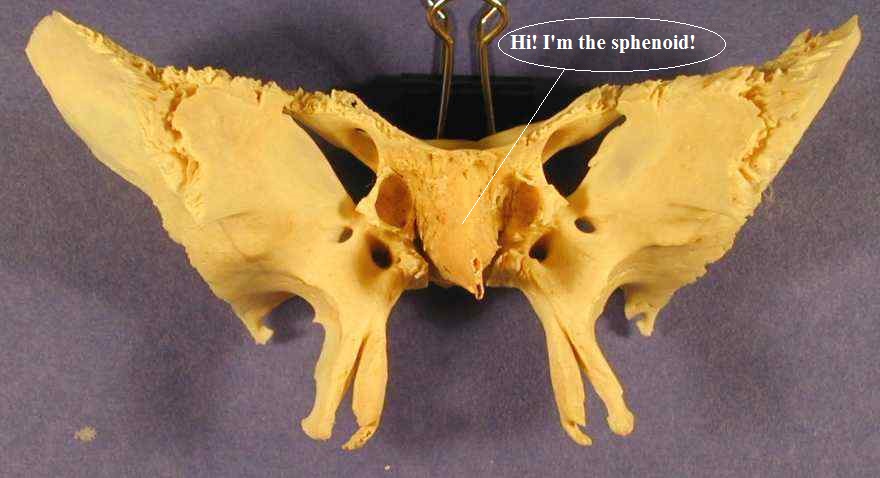The Splendiferous Sphenoid and the Frelling Fibula
It's a butterfly! It's a bat! It's the sphenoid!

For this final article, I have reserved my favorite bone, the sphenoid. I'm sure you've all heard of the previous bones featured in this column, but the sphenoid may be unfamiliar. It's a not a very apparent bone, unlike teeth or the clavicle, and neither is it a commonly mentioned one, unless you are taking osteology. In which case, you may groan about it. But I love it.
The sphenoid takes its name from the Greek word meaning "wedge-like," though I think that's a misnomer, because to me (and to many osteology students), it actually resembles either a butterfly or a bat. See? The title of this section isn't just a bit of cheek; it has a purpose. The sphenoid is a cranial bone, located in front of the temporal bone (the bone that makes up your temple) and the basilar occipital bone (approximately the base of the bone at the back of your head). It is also one of the seven bones that forms the eye orbit, situated on the lateral side (the side away from the midline of your body).

I'll skip the anatomy of the sphenoid bone, as that's really not the purpose of this column, but suffice it to say, many of my fellow osteology students cursed it plenty. I didn't. I thought its skeletal landmarks (the features that are used to identify it) were rather unique and logically named. The sella turcica, for example, means "Turkish chair," and it actually looks like a saddle. Which is quite convenient when you need to identify it or to remember its purpose (holds the pituitary gland, along with the sphenoidal sinuses). Or take the greater and lesser wings. They are the "wings" of the bat or butterfly, or at least are the wing-like projections that come off the main body of the sphenoid. Coolest of all, though, is the fact that it's super easy to determine how it sits in the body. Just hold up the sphenoid so that it looks like the butterfly or bat is flying towards you. See? Logical. I will never understand why so many people disliked it.
Like every other bone, the sphenoid has a few important functions. It helps form the base of the cranium, the sides of the skull (at the temples), and the walls of each eye orbit. The muscles of mastication (muscles used in chewing) are attached there. Nerves and blood vessel pass through its foramina (holes), carrying messages and oxygenated blood to the head and neck. Without the sphenoid, part of our eye wall might collapse; we may have difficulty chewing; and we may, in fact, be slightly stupider. So clearly, it is a very helpful bone.
Aaaand Here's the Frelling Fibula

Another bone that has a purpose is the fibula, though believe me, I am loath to admit it. Out of all the bones in the body, I like the fibula least. In fact, I hate it. Despise it. Would like to take a fibula and smash it against a desk. Or at least I wanted to, when I was taking osteology. Why, you ask? Well, it's simple. It lacks the sphenoid's elegance. But before we get to my personal feelings on it, let's cover some of the basics.
The fibula is your calf bone, the bone located on the lateral side (the side away from the midline of your body) of your lower leg, beside the tibia (shin bone). It sits below the knee joint and above the ankle joint, of which it is the lateral part. It's also much smaller and more delicate than the tibia, so it often fractures, particularly midshaft and at the ankle.
Unlike the arm and other leg bones, the fibula doesn't support much weight. Instead, it provides stability for the ankle and attachments for some of the calf muscles. So whenever your ankle gives way (i.e. rolls to the side), you can blame the fibula. Because it's the fibula's fault. The frelling, useless bone can't even do its one job reliably.
But I digress.
The fibula has a strange shape; it is long and narrow, with ends that are concave on one side and somewhat pointed on the other. Some people think it resembles a brooch or a clasp (like that on a safety pin), and there is actually a type of brooch called the fibula. This alleged similarity inspired an anatomist to name the calf bone after it in 1706. Personally, I think it just looks weird, not really like a brooch, but I can sort of see the safety pin clasp if I squint really hard.
Truthfully, I dislike the fibula for many reasons, some of which are actually valid, unlike its shape (it can't help that it looks moronic). I simply never took to it--or to its sparse skeletal landmarks. Compared to other bones, it's pretty anatomically barren. Maybe that's another reason I don't like it; it's boring. It has no fun names like "pterygoid process" and "sella turcica" (sphenoid), or "acetabulum" and "auricular surface" (pelvis). No, it has features like "head of fibula," "anterior border," and "medial crest."
In the words of Sherlock Holmes, "Dull, boring, predictable."
Reference:
1. White TD and Folkens PA. 2005. The Human Bone Manual.






